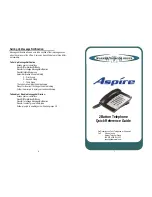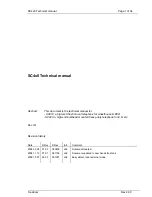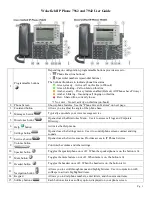
11
Important Information
System regulatory information
For United States Installations
This equipment complies with Part 68 of the FCC rules and/or the
requirements adopted by the Administrative Council for Terminal
Attachments (ACTA). On the bottom of this equipment is a label that
contains, among other information, a telephone products identifier in the
form FCC ID: EF4 ... or US: EF4 ... and ringer equivalence number (REN). If
requested, this information must be provided to the telephone company.
A plug and jack used to connect this equipment to the premises wiring and
telephone network must comply with the applicable FCC Part 68 rules and
requirements as adopted by the ACTA. If provided, a compliant telephone
cord and modular plug is included with this product. The jacks and plugs
are designed to be connected to a compatible modular jack that is also
compliant. See installation instructions for details.
A ringer equivalence number code (REN) is used to determine the quantity
of devices that may be connected to the telephone line. Excessive RENs
on a telephone line may result in the devices not ringing in response to
an incoming call. If most, but not all areas, the sum of the RENs should
not exceed five (5.0). To be certain of the number of devices that may
be connected to the line, as determined by the total RENs, contact the
telephone company to determine the maximum REN for the calling area.
For products approved after July 23, 2001, the REN for this product is part
of the product identifier that has the format US: AAAEQ##TXXX. The digits
represented by the ## are the REN without a decimal point (e.g., 03 is REN
of 0.3). For earlier products, the REN is separately shown on the label.
If this equipment causes harm to the telephone network, the telephone
company will notify you in advance that temporary discontinuance of service
may be required. But if advance notice is not practical, the telephone company
will notify the customer as soon as possible. Also, you will be advised of your
right to file a complaint with the FCC if you believe it is necessary.
The telephone company may make changes in its facilities, equipment,
operations or procedures that could affect the operation of the equipment. If this
happens, the telephone company will provide advance notice in order for you to
make the necessary modifications in order to maintain uninterrupted service.
If trouble is experienced with this equipment, for repair and/or warranty
information contact Linear Corporation at 1-800-421-1587 for information
or a return product authorization (RPA). If the trouble is causing harm to the
telephone network, the telephone company may request you remove the
equipment from the network until the problem is resolved. User repairs must
not be made. Doing so voids warranty.
This equipment must not be used on telephone company provided public
coin service. Connection to party lines is subject to state tariffs. Contact your
state public utility commission for information. This equipment is hearing
compatible (HAC) to any HAC compatible attached handset telephones.
Alarm Dialing Equipment:
If your home has specially wired alarm equipment connected to the telephone
line, ensure that the installation of any other non-alarm devices does not
disable your alarm equipment. If you have questions about what will disable
alarm equipment, consult your telephone company or a qualified installer.
When Programming Emergency Numbers Or Making Test Calls To
Emergency Numbers.
1. Remain on the line and briefly explain to the dispatcher the reason for
the call.
2. Perform such activities in the off-peak hours, such as early mornings or
later evenings.
3. Follow the central station operator’s instructions for updated dialer
programming, if re-programming of the dialer is required.
Alarm dialing equipment must be able to seize the telephone line and
place a call in an emergency situation. It must be able to do this even if
other equipment (telephone(s), answering system, computer modem, etc.)
already has the telephone line in use. To do so, alarm dialing equipment
must be connected to a properly installed RJ31X that is electrically in series
with and ahead of all other equipment attached to the same telephone line.
If you have any questions concerning these instructions, you should consult
your telephone company or a qualified installer about installing the RJ31X
jack and alarm dialing equipment for you.
Alarm Installation Notes to Installer:
For products equipped with an RJ31X jack the line seize feature shall be
verified. Be certain the local telephone and incoming line connections
are not reversed. These lines are not reversed if the alarm dialer can
communicate with the central station.
New Services Notes to User:
The installation and/or monitoring company shall be notified if new telephone
service, e.g. DSL, is installed.
For Canadian Installations
The Industry Canada (IC) label identifies certified equipment. This
certification means that the equipment meets certain telecommunications
network protective, operational and safety requirements. The IC does not
guarantee the equipment will operate to the user’s satisfaction.
Before installing this equipment, users should ensure that it is permissible
to be connected to the facilities of the local telecommunications company.
The equipment must also be installed using an acceptable method of
connection. In some cases, the company’s inside wiring associated with
a single line individual service may be extended by means of a certified
connector assembly (telephone extension cord). The customer should
be aware that compliance with the above conditions may not prevent
degradation of service in some situations.
Repairs to certified equipment should be made by an authorized Canadian
maintenance facility designated by the supplier. Any repairs or alterations
made by the user to this equipment, or equipment malfunctions, may give
the telecommunications company cause to request the user to disconnect
the equipment.
Users should ensure for their own protection that the electrical ground
connections of the power utility, telephone lines and internal metallic water
pipe system, if present, are connected together. This precaution may be
particularly important in rural areas.
CAUTION:
Users should not attempt to make such connections
themselves, but should contact the appropriate electric inspection authority,
or electrician, as appropriate.
The Load Number (LN) assigned to each terminal device denotes the
percentage of the total load to be connected to a telephone loop which is
used by the device to prevent overloading. The termination on a loop may
consist of any combination of devices subject only to the requirement that
the total of the Load Number of all the devices does not exceed 100.
The Ringer Equivalence Number (REN) is used to determine the quantity
of devices that may be connected to the telephone line. Too many devices
may result in some devices not ringing in response to an incoming call. In
most, but not all areas, the sum of the REN’s should not exceed five (5.0).
To be certain of the number of devices that may be connected to the line,
contact the telecommunications company to determine the maximum REN
for the calling area
Refer to the equipment label for the unit’s load number or REN number.
Important Wireless Information
Linear radio controls provide a reliable communications link and fill an
important need in portable wireless signaling. However, there are some
limitations which must be observed.
• For U.S. installations only: The radios are required to comply with FCC
Rules and Regulations as Part 15 devices. As such, they have limited
transmitter power and therefore limited range.
• A receiver cannot respond to more than one transmitted signal at a time
and may be blocked by radio signals that occur on or near their operating
frequencies, regardless of code settings.
• Changes or modifications to the device may void FCC compliance.
• Infrequently used radio links should be tested regularly to protect against
undetected interference or fault.
• A general knowledge of radio and its vagaries should be gained prior
to acting as a wholesale distributor or dealer, and these facts should be
communicated to the ultimate users.






























